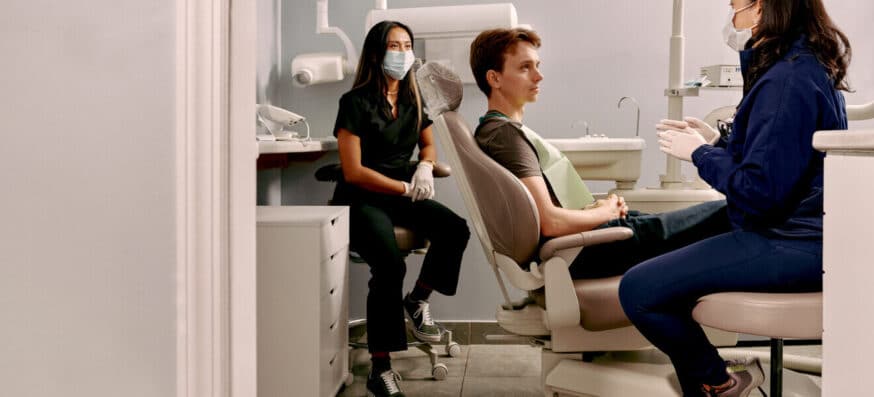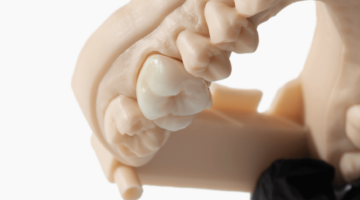Asking what compels patients to visit dentists can lead to a list of complex answers and a dive into patient behavior. Some may say that patients are being more diligent with their oral health. At the same time, individuals may share that their fear of something worsening drives them to at least an annual or bi-annual visit. Still, many hold out and will only see a dentist when the situation has progressed so far that it is almost a dental emergency. Their reasoning is due primarily to fear of cost, lack of insurance, or anxiety over the dental experience.
The good news is that in the last 40 years, there has been an effort by many organizations to move patients away from seeking reactive dental support to a more proactive approach. The American Dental Association (ADA), and other educational outreaches have a concerted effort to promote and motivate people to dental awareness and proactive health. Even the U.S. Department of Health and Human Services which is aligned with the World Health Organization initiative Healthy People 2030 is taking great steps towards its objective of reaching the most disadvantaged populations for primary dental care. And it seems to be working.
A 2018 study analyzed the effectiveness of “educational interventions performed in health services in the improvement of clinical behaviors and outcomes in oral health.” After searching and evaluating articles that met their criterion, researchers discovered that “most studies evaluating behavioral and periodontal outcomes have shown significant improvements in favor of interventions.”
A Public Health Institute research brief published by the ADA echoed the earlier analysis. It suggests a shift in “dental practice patterns, with providers focusing less on treating the destructive sequelae of oral diseases to overwhelmingly maintaining patients’ sound oral health.” This shift is revealed chiefly in statistics that reflect less intensive procedures than the preventative maintenance and routine filling of clearies. Pointing to this is the 2018 statistic cited in the aforementioned research brief that states that 75.3% of procedures performed by dental professionals were diagnostic or preventive. This statistic is higher compared to 63.7% in 2001.
Still, according to the Centers for Disease Control, 65.5% of adults aged 18−64 had a dental visit during 2019. That means 34.5% of that population did not seek help for various reasons. So, what compels patients to seek out a dentist? After researching and reviewing evidence across the dental field, we have found significant causes for seeking out the aid of a dental professional. We have divided them into proactive and reactive causes.
Proactive factors and causes why patients seek a dentist.
It’s time for a checkup
A patient who schedules and proceeds with a regular check up is one of the almost 67% of Americans who choose proactive dental and oral health. Improved oral health is an indicator of overall health. By visiting a dental health care provider periodically, patients are preventing the spread and complications arising from oral (tooth decay) and periodontal disease (gum disease), caries (cavities), oral cancer, and the associated cost of advanced treatment. If they recognize that oral health is also a window into patients’ health, including cardiovascular disease and endocarditis, patients may be compelled to visit more often. Checks ups are necessary for preventative maintenance and they keep costs, cavities, and other complications down.
Ongoing treatment
When patients are in the process of having ongoing treatment, they need to be encouraged to finish, especially in the case of restorative dentistry. This type of dentistry is often performed by general dentists who provide several procedures, including crowns, bridges, implants, and dentures. Cavities and damaged or missing teeth have priority. Without them, overall patient health is in jeopardy, especially when it impacts patient functionality. Why a patient would not follow through on treatment needs to be addressed. Besides the lack of insurance coverage or ability to pay, there may be an issue with the dentist-patient relationship.
Patients who feel their dental professional is not hearing them will “ghost” the office’s outreach and refuse contact. If there is a significant incident, the dentist needs to reach out personally to resolve the issue. Investigating the root cause of the situation can bring it to an amenable end.
Pregnancy
Pregnant women often develop gum disease and cavities due to the increased hormones, vascular changes, and modified nutrition during pregnancy. The ADA Center for Professional Success Oral Health Care Series report on Women’s Oral Health Issues shows that nearly “60 to 75% of pregnant women have gingivitis, an early stage of periodontal disease.” Gums become red and swollen from inflammation. Without treatment, the condition can lead to further complications.
Pregnant mothers tend to have acidic erosion with prolonged morning sickness and vomiting. Cravings and questionable nutritional variations during their baby’s gestation also contribute to increased cavities. Even the mother’s periodontal condition is paralleled to the child’s term weight. As such, it is recommended that expectant mothers need more dental visits. Until then, mothers should continue brushing twice daily and flossing. If they are experiencing prolonged morning sickness, there are treatments, such as a water and baking soda rinse, that can be an antidote to the acid left behind that breaks down teeth enamel.
Chronic conditions or diseases
Oral health can be complicated for patients with a wide range of autoimmune disorders or chronic conditions such as diabetes, obesity, heart disease, or hepatitis C. These health conditions may increase an individual’s risk of poor oral health, leading to infection and missing teeth. A word of advice, inform patients to schedule check ups that coincide with their doctor visits. A good rule of thumb is once every four months.
Environmental experience
One factor that is not necessarily health-related is the experience dentists, and office teams create for the patient. Dandy and their many subject matter expert dentists recognize that the dental experience incorporates everything from front desk personnel to your practice’s offerings and the aesthetics of your office. Combined, they are a recipe for success. Try to see things from the patient’s point of view. Turn to Dandy and its Learning Center page for more insights and ideas on creating the best patient experience that guarantees a return visit.
Reactive factors and causes why patients seek dentists.
An emergency
It seems unfair to include this reason on the list. Every emergency is reactive. You can prepare, but you react to the situation at that moment. However, there are occasions when the entire incident is avoidable. How you respond and where you seek help are critical to the process.
More and more dental patients are going to the emergency rooms for entirely preventable events. The statistical brief Emergency Department Visits Involving Dental Conditions indicated that “Among treat-and-release ED [emergency departments] visits with a principal diagnosis of a dental condition, three groups of dental conditions accounted for 93 percent of visits—loss of teeth and similar disorders, diseases of the pulp and periapical tissues, and dental caries.”
Unfortunately, these visits cost the government, taxpayers, and hospitals a significant amount of money. Dentistry Today cited a study that stated emergency room visits are rising annually. They “constitute 1.15% and 2.5% of all emergency room visits.” While that amount may seem minor, combined, “these visits cost about $2 billion each year.” From the statistical brief mentioned above, it was discovered that “more than two-thirds of dental-related ED visits were expected to be billed to Medicaid or were self-pay/no charge.” Perhaps what is needed is an alternative to an emergency room or more dental professionals in the ER.
It is given that dental offices do not have the same hours as an ER. Still, the best place for an emergency dental patient is with a dentist. And emergency departments and hospitals often become the provider of last resort. What needs to be addressed is that ED staff have a different education than dental professionals. They may not be aware that dental infections can quickly spread to the surrounding teeth and may also infect the body. And they certainly cannot provide the same level of care a dentist can. What the result is patients released with antibiotics (not always the right kind) and pain medication. Having dental care providers on staff, like oral and maxillofacial surgeons or triaging hygienists, may provide the answers for treating dental patients in emergency departments.
One program taking steps to mitigate this issue is the Oral Health Program of the Rhode Island Department of Health (RIDOH). In one year there were 1,800 Rhode Island Hospital emergency department patients treated onsite. Through the created referral system, patients in community hospitals were referred to safety net dental health clinics to guarantee a proper continuity of care.
As a result, “the likelihood of seeing the same patient in the hospital for a dental emergency is declining thanks to emergency department referral programs.” Because of this program, emergency room physicians can seek consults and contact the on-call dentists to treat patients onsite.
Pain
Any oral pain is a good reason for a patient’s dental visit. What is more important is determining the cause. There are several sources for the pain and what it could be attributed to:
- Tooth pain: Tooth pain often is an indication of an underlying issue. Once the tooth is examined, the dental professional can know the cause. However, if left untreated, the situation will not improve. Identifying the source of the pain can aid in developing a course of action. Tooth decay in the early stages can cause a cavity, which is not painful until they are in advanced stages. Decay can affect the tooth’s pulp causing an abscess and other complications, and thus, pain.
- Gum pain: If it is gum or periodontal disease causing pain, the gums will show signs of being red, swollen, and painful. Regular dental checkups and visits can prevent the onset of gum disease if caught in time.
- Sore teeth and jaw pain: Pain in the mouth can actually emanate from the jaw. A malocclusion or misalignment of the upper and lower jaws can have several causes and classifications. According to MedLinePlus, they are:
- Class 1 malocclusion is the most common. The bite is normal, but the upper teeth slightly overlap the lower teeth.
- Class 2 malocclusion, called retrognathism or overbite, occurs when the upper jaw and teeth severely overlap the bottom jaw and teeth.
- Class 3 malocclusion, called prognathism or underbite, occurs when the lower jaw protrudes or juts forward, causing the lower jaw and teeth to overlap the upper jaw and teeth.
Crowded teeth, overbites, crossbite underbites, and open bites may interfere with essential jaw functionality. It can also cause soreness in the jaw and uneven wear on teeth. The symptoms and discomfort may become so bad that a patient seeks help after tolerating it for some time. It can be instrumental in developing an emergency.
Lastly, pain does not have to originate in the teeth, gum, or jaw to have oral pain. There are non-dental originations for pain. The head or cranium and jaw are covered with muscles that can become strained and sore with over use. Sometimes, this pain is hard to ascertain its source and can be misidentified as tooth pain. Another source for pain in the mouth, jaw, and teeth are sinus infections.
The Mayo Clinic describes sinuses as “pairs of empty spaces in your skull connected to the nasal cavity.” These hollow cavities–the Frontal, Ethmoid, Maxillary,and Sphenoid–are a connected system. When the tissues and lining in those spaces become filled with fluid and inflamed, they can cause pain. With the largest sinuses located above the upper back teeth, the pressure can cause pain into the roots of those teeth. And those same teeth, when infected or injured, can cause inflammation in those same sinus cavities. As the sinus system is interconnected, it is no wonder that the teeth can be affected by any infection in the head.
Damaged teeth
There are multiple ways a tooth can become damaged. Many of these include accidents. It is understandable when a patient tries to see the dentist when a chipped or broken tooth proves painful.
The tooth may need significant restorative work or removal if the tooth is cracked. As for chipped teeth, they have been known to cut the tongue and the inside of the cheek. The sharp edges of a tooth will continue to injure areas of the mouth. Patients who find themselves in a reactive situation will deem it an emergency and seek a dentist or go to the emergency room. The best place for these patients is in a dental chair where a dentist can repair or remove teeth and prevent further pain or possible infection.
Sores in the mouth or on the tongue
Mouth sores or lesions can have multiple causes, show up anywhere in the oral cavity or throat, and affect people of any age. Most of all, they are bothersome, and patients want them to be gone. Many sores can be considered benign, but they need to be examined if they are persistent. A dental professional can be instrumental in diagnosing the type of lesion and its course of treatment.
How to increase frequency of visits
With the patients’ health top-of-mind, utilize this information to motivate them to come into your practice at the appropriate frequency. While they are in the chair, let patients know that they can eliminate painful reactive and expensive dental procedures by adding proactive motions, such as regular checkups, to their routine. Actions like regular maintenance and simple procedures also go far in averting larger overall health problems. These messages should also appear on your marketing materials, website, and social media to remind current patients and encourage prospective patients to schedule an appointment with your practice.



